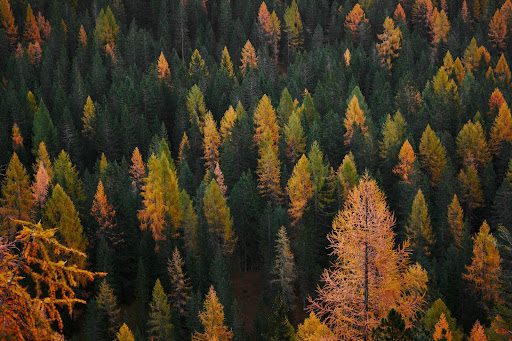In New England, we enjoy a heavily forested countryside with many discrete forests all over. However, you’ve probably noticed that barring the differences between the balance of specific species and deciduous vs. coniferous trees, the forests throughout New England are all very similar. This is especially true when you contrast these forests with those in places like the Amazon in South America, where tropical rainforest is dominant. Today’s blog is going to focus on comparing the forests of New England to the forest types found throughout the world.
What Kind of Forest Do We Have In New England?
In New England, we have what are called temperate forests. On the surface, this simply means that the forests grow in the latitudinal range between the tropics and the 50th parallel. Generally, in this attitudinal range, there are temperatures between -22 F and 86 F that plants and animals have to survive and thrive in. In practical terms, this means that the forests are adapted to the seasonal range of climatic conditions experienced outside the planet’s tropical/subtropical and arctic/antarctic regions. This means that deciduous trees go dormant in winter, shedding their leaves and essentially hibernating through the cold months with reduced sunlight, focusing their photosynthetic efforts on the brighter, warmer months of the year.
Temperate forests account for a little less than 20% of the world’s forest cover and provide habitat to what we commonly think of as “woodland creatures” such as squirrels, deer, bobcats, lynx, skunks, bears, raccoons, and so on. Most of these fauna are also adapted to the seasonal nature of this environment, with more activity to gather the more abundant food in the warmer months and either reduced activity or outright hibernation in the coldest winter months when less food is available and more calories are needed to stay warm.
Temperate forests generally have fertile soil enriched by the forests themselves, maintaining rich mulching leaves and healthy fungal populations that create good soil. The trees and other flora have wide, strong root systems that help maintain the integrity of the soil, protecting it from erosion, too. This is important because temperate forests usually receive between 30 and 59 inches of rain each year, leading to seasonal or occasional flooding that could otherwise wash away the rich soil.
There are technically three variants of temperature forests: Coniferous, deciduous, and rainforests. In New England, we have a mix of deciduous (leaf shedding) and coniferous (evergreen) forests. However, other parts of the US and the world have temperate rainforests with very high rainfall rates, generally over 140 inches annually!
What Are Other Types Of Forest In The World?
If we have “temperate” forests in New England, it’s only logical that warmer and colder parts of the world with less temperate climates have more specialized forests adapted to those climatic zones. Indeed, this is the case with warmer climates hosting “tropical” forests and colder regions carrying “boreal” forests.
Tropical Forests
Logically, tropical forests are located in the tropics, between the Tropic of Cancer (23 degrees North) and the Tropic of Capricorn (23 degrees South). The tropics have the most stable climate on earth, with tropical forests enjoying average daily temperatures between 68 F and 77 F, and often a very high amount of rainfall ranging from 79 to 394 inches of annual rain on average.
Tropical forests cover roughly 10% of all land mass and contain almost half the species on earth. Unsurprisingly, this means that tropical forests have the most biodiverse ecosystems on the planet. Unfortunately, these tropical forests are also the ones most often under direct threat by human activity, with over-harvesting to clear forested land being very common in these regions.
There are four variants of tropical forests: Evergreen, Moist, Dry, and Mangrove. “Evergreen” tropical forests are what we typically think of when we hear “tropical rainforest,” they’re the wettest and the most biodiverse on average. “Moist” tropical forests are generally farther from the equator than evergreen tropical forests and have more seasonal variation as a result. “Dry” tropical forests have dry periods that last from 4 to 6 months every year, and the plants and animals have adapted to this dry season. “Mangrove” tropical forests are coastal forests that have adapted to brackish water and often host a lot of juvenile aquatic species.
Boreal Forests
North of our temperate zone, there are “boreal” forests from the 50th parallel up to the 60th parallel. These occur on all the continents in this zone, North America, Europe, and Asia. In some ways, these are the opposite of tropical forests, with relatively little biodiversity thanks to a climate with more extreme swings that require greater specialization of species. Average daily temperatures range from as low as -22 F in winter up to as high as 80 F during their brief summers.
This far Northern placement means that about four-fifths of boreal forests are growing on permafrost and do so with far less precipitation than other forests, with averages between 15 and 20 inches annually. This paucity of sunlight, warmth, and rain contributes to the poor, acidic, shallow soil quality of these forests when compared to both temperate and tropical forests.
That said, these conifer-heavy forests are home to both seasonal and year-round fauna, such as Caribous, Lynx, and many species of birds that migrate South to avoid the harsh winters. Being so remote and largely untouched by human activity makes boreal forests excellent carbon sinks compared to either temperate or tropical forests, where faster turnover and human activity result in less stable carbon storage. As the planet warms, these forests are endangered since the permafrost many trees rely on for stability is receding every year.
Managing Maine and New Hampshire Forests
What’s important to learn from the differences between the forests in New England and other climates is how our own climate may shift and change in response to climate change and what signs to watch for in the makeup of the forest to track these kinds of changes. This doesn’t impact short-term plans leading to your next harvest but becomes an important part of robust management plans going into the more distant future.
If you want to learn more about your forest and arrive at a forest management plan to make it as productive and healthy as possible, get in touch with Tall Pines Forest Management.


0 Comments